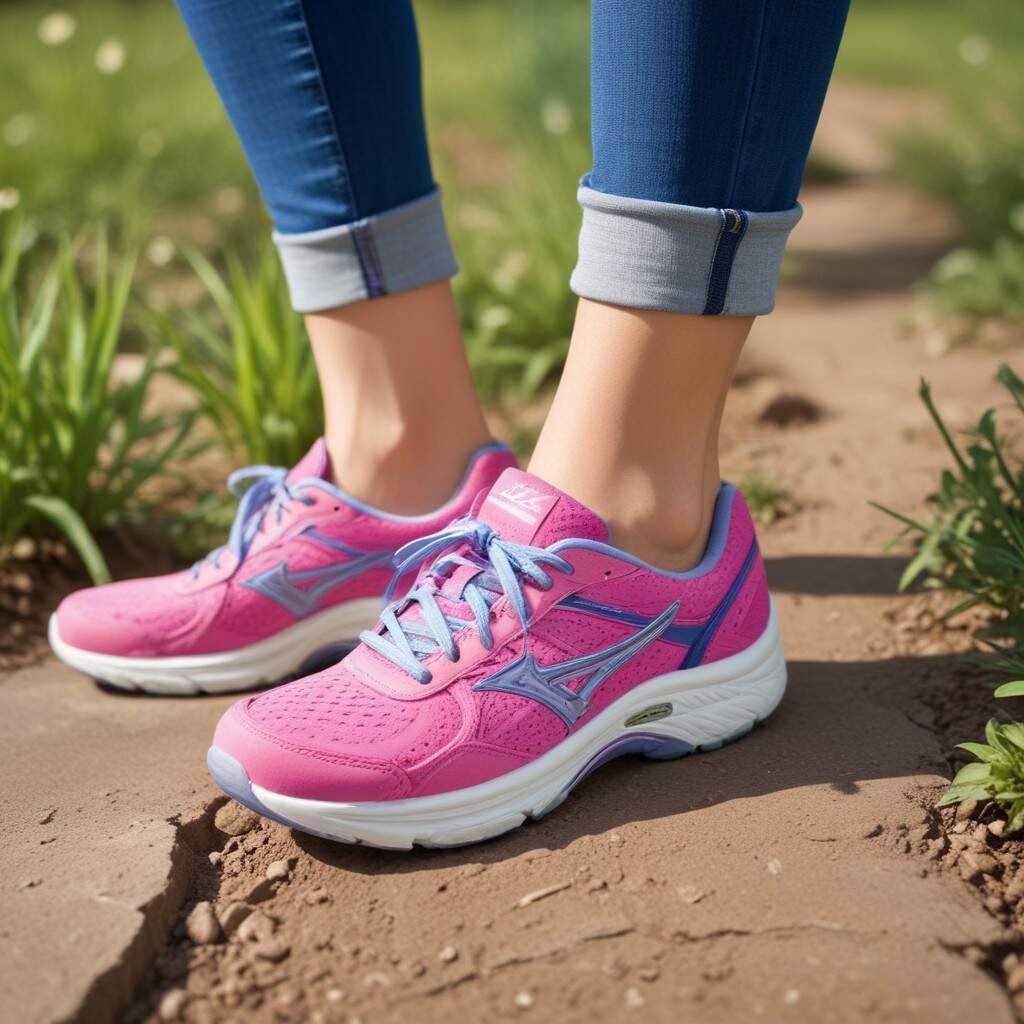Explores features of Best Shoes for Plantar Fasciitis, including arch support, cushioning, and stability. Recommendations for women’s and men’s shoes are listed. Additional factors like activity level and foot type are covered.
What is Plantar Fasciitis?
Plantar fasciitis is a common and often debilitating condition that affects the thick band of tissue running along the bottom of the foot, known as the plantar fascia.
Inflammation, pain, and stiffness in the heel and arch area can plague you with plantar fasciitis. This condition can make everyday activities like walking and standing extremely uncomfortable. Often caused by overuse, excessive strain, or improper foot mechanics, plantar fasciitis can significantly impact your quality of life if left untreated.pen_sparktunesharemore_vert
Understanding the Importance of Proper Footwear for Plantar Fasciitis
Proper footwear is crucial for individuals suffering from plantar fasciitis, as it can play a significant role in managing the condition and reducing the associated pain and discomfort. Shoes that provide adequate arch support, cushioning, and stability can help alleviate the strain on the plantar fascia, allowing for more comfortable and pain-free movement. Conversely, ill-fitting or unsupportive shoes can exacerbate the symptoms of plantar fasciitis, leading to further inflammation and discomfort.

Common Features to Look for in Shoes for Plantar Fasciitis
When selecting shoes for plantar fasciitis, there are several key features to consider:
- Arch Support: Shoes with strong, rigid arch support can help maintain the natural alignment of the foot and reduce the strain on the plantar fascia.
- Heel Cushioning: Ample cushioning in the heel area can absorb shock and impact, preventing further irritation of the plantar fascia.
- Stability: Shoes with a sturdy, well-constructed sole and a firm heel counter can provide the necessary stability and control to prevent excessive pronation or supination.
- Flexibility: While the shoe should be stable, it should also allow for some natural flexibility in the forefoot to accommodate the foot’s natural range of motion.
- Breathability: Shoes with a breathable upper material can help regulate temperature and reduce moisture buildup, which can contribute to further irritation.

Best Shoes for Plantar Fasciitis – Women’s Edition
For women dealing with plantar fasciitis, the following shoes are highly recommended:
- Brooks Adrenaline GTS 21: This stability running shoe offers exceptional arch support, cushioning, and motion control to alleviate plantar fasciitis symptoms.
- Asics Gel-Kayano 27: With its renowned Gel technology and medial posting, this shoe provides excellent shock absorption and stability for women with plantar fasciitis.
- New Balance 1540v3: Featuring a sturdy, dual-density foam midsole and a reinforced heel, this shoe offers superior support and control for those with plantar fasciitis.
- Saucony Guide ISO 2: This stability shoe boasts a responsive midsole, a durable outsole, and a supportive upper to provide a comfortable and pain-free experience for women with plantar fasciitis.
- Orthofeet Coral: Designed with orthopedic features, this shoe offers exceptional arch support, cushioning, and a roomy toe box to accommodate the unique needs of those with plantar fasciitis.
Best Shoes for Plantar Fasciitis – Men’s Edition
For men dealing with plantar fasciitis, the following shoes are highly recommended:
- Brooks Adrenaline GTS 21: This stability running shoe, available in both men’s and women’s versions, offers exceptional arch support, cushioning, and motion control to alleviate plantar fasciitis symptoms.
- Asics Gel-Kayano 27: With its renowned Gel technology and medial posting, this shoe provides excellent shock absorption and stability for men with plantar fasciitis.
- New Balance 1540v3: Featuring a sturdy, dual-density foam midsole and a reinforced heel, this shoe offers superior support and control for those with plantar fasciitis.
- Saucony Guide ISO 2: This stability shoe boasts a responsive midsole, a durable outsole, and a supportive upper to provide a comfortable and pain-free experience for men with plantar fasciitis.
- Orthofeet Monterey Bay: Designed with orthopedic features, this shoe offers exceptional arch support, cushioning, and a roomy toe box to accommodate the unique needs of those with plantar fasciitis.

The Benefits of Walking Shoes for Plantar Fasciitis
While running shoes can be an excellent choice for individuals with plantar fasciitis, walking shoes can also offer significant benefits.
Walking shoes actively provide a solid foundation for the foot with a more flexible and stable sole, allowing for natural movement at the same time.pen_sparktunesharemore_vert
This can be particularly helpful for those who engage in regular walking or light exercise routines, as the reduced impact and enhanced support can help alleviate the strain on the plantar fascia.
Tips for Selecting the Right Shoes for Plantar Fasciitis
When choosing shoes for plantar fasciitis, it’s important to consider the following tips:
- Get Properly Fitted: Visit a reputable shoe store or a podiatrist to ensure you’re selecting the right size and fit for your feet.
- Try on Shoes in the Afternoon: Feet tend to swell throughout the day, so trying on shoes in the afternoon can help ensure a proper fit.
- Prioritize Comfort Over Style: While aesthetics are important, comfort should be the primary consideration when selecting shoes for plantar fasciitis.
- Replace Shoes Regularly: Worn-out shoes can lose their support and cushioning, so it’s essential to replace them every 300-500 miles or every 6-12 months, depending on usage.
- Consider Orthotic Inserts: If the shoes alone don’t provide enough support, you may benefit from adding custom or over-the-counter orthotic inserts.

Additional Considerations for Choosing Shoes for Plantar Fasciitis
In addition to the features and tips mentioned above, there are a few other factors to consider when selecting shoes for plantar fasciitis:
- Activity Level: High-impact activities like running or aerobics demand a shoe with more robust cushioning and stability features.
- For lower-impact activities, like walking or everyday wear, a more flexible and lightweight shoe may be suitable.
- Foot Type: Individuals with different foot types (e.g., flat feet, high arches) may require specific shoe features to address their unique needs and provide the necessary support.
- Pronation Pattern: Understanding your pronation pattern (overpronation, underpronation, or neutral) can help you choose a shoe that corrects any imbalances and provides the appropriate level of stability.
- Occupational Demands: If you have a job that requires prolonged standing or walking, it’s crucial to select shoes that can withstand the demands of your work environment while still providing the necessary support for plantar fasciitis.
Reviews of the Top-Rated Shoes for Plantar Fasciitis
Plantar fasciitis can be a real pain (literally!). But don’t worry, getting back on your feet doesn’t have to be a struggle. The right shoes can make a huge difference. We’ve checked out some of the most popular picks for plantar fasciitis and put together a quick rundown to help you find your perfect match.
Brooks Adrenaline GTS 21:
This stability running shoe has received overwhelmingly positive reviews from customers who praise its exceptional arch support, cushioning, and ability to alleviate plantar fasciitis symptoms. Many users report a significant reduction in heel and arch pain after switching to the Adrenaline GTS 21.
Asics Gel-Kayano 27:
Customers consistently rave about the Gel-Kayano 27’s superior shock absorption and stability, which have helped them manage their plantar fasciitis effectively. The shoe’s durable construction and responsive midsole have also been widely praised.
New Balance 1540v3:
Users with plantar fasciitis have found the 1540v3 to be a game-changer, highlighting its excellent arch support, heel stability, and overall comfort. Many have reported a significant improvement in their symptoms after switching to this shoe.
Saucony Guide ISO 2:
Reviewers with plantar fasciitis have praised the Guide ISO 2’s ability to provide a comfortable, pain-free walking and running experience. The shoe’s responsive midsole and supportive upper have been particularly well-received.
Orthofeet Coral/Monterey Bay:
Customers with plantar fasciitis have consistently praised the Orthofeet line for its exceptional arch support, cushioning, and overall comfort. Many have found significant relief from heel and arch pain after transitioning to these orthopedic-friendly shoes.
If you’re struggling with plantar fasciitis, don’t let it hold you back. Explore the top-rated shoes featured in this guide and take the first step towards finding the perfect pair that can help alleviate your symptoms and get you back on your feet. Remember, investing in the right footwear is an important part of managing this condition and improving your overall quality of life.
Conclusion
Plantar fasciitis can be a debilitating condition, but with the right pair of shoes, you can find relief and regain your active lifestyle. By prioritizing features like arch support, cushioning, and stability, you can choose shoes that will effectively manage the strain on your plantar fascia and help you move with comfort and confidence. Remember to consider your individual needs, activity level, and foot type when selecting the best shoes for your plantar fasciitis, and don’t hesitate to seek professional advice if needed. With the right footwear and a proactive approach to your foot health, you can overcome the challenges of plantar fasciitis and enjoy pain-free movement.



Leave a Reply